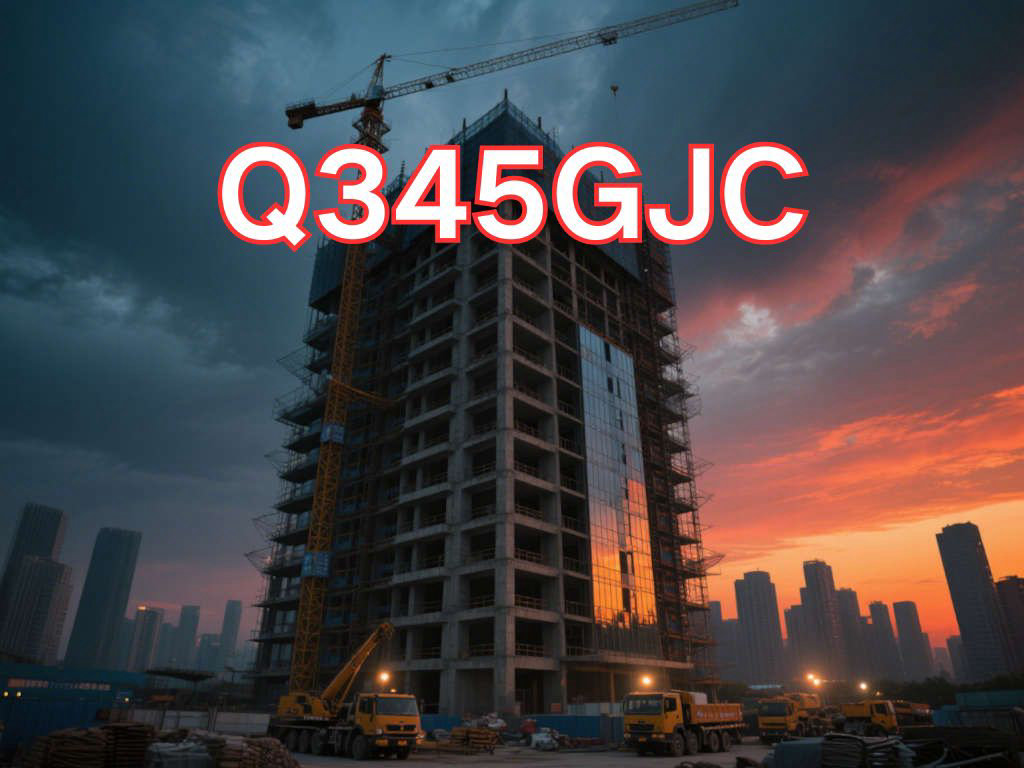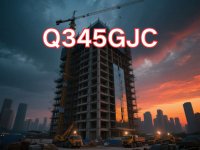

Q345GJC
Q345GJC is a high-strength low-alloy structural steel with excellent weldability, low-temperature toughness, and seismic resistance. With a minimum yield strength of 345 MPa, it is widely used in high-rise buildings, bridges, and large-scale engineering structures, especially for welded load-bearing components requiring high toughness.
Grade Designation
Q: Stands for "Qu" (Chinese pinyin for "yield"), indicating yield strength;
345: Minimum specified yield strength of 345 MPa (for thickness ≤16 mm);
GJ: Abbreviation for "Gao Jian" , meaning "steel for high-rise buildings";
C: Quality grade C, indicating Charpy V-notch impact testing at 0°C is required, with an average absorbed energy ≥34J (KV2). Suitable for moderate low-temperature environments.
Physical Properties
Density: 7.85 g/cm³
Elastic Modulus: ~206 GPa
Thermal Expansion Coefficient: ~12×10⁻⁶/°C (20–100°C)
Thermal Conductivity: ~48–52 W/(m·K)
Yield Strength (ReH): ≥345 MPa (for thickness ≤16 mm)
Tensile Strength (Rm): 470–630 MPa
Elongation after Fracture (A): ≥21% (Lo=50mm, thickness ≤16 mm)
Low-Temperature Impact Toughness: Average absorbed energy ≥34J at 0°C (KV2, average of three specimens, individual value ≥24J)
Chemical Composition
Q345GJC achieves its properties through microalloying and controlled rolling, with strictly controlled chemical composition:
| Element | Content (wt%) | Function |
|---|---|---|
| C | ≤0.20% | Limits carbon equivalent to ensure weldability |
| Si | ≤0.50% | Deoxidizer, increases strength |
| Mn | 1.00–1.70% | Enhances strength and toughness, improves hardenability |
| P | ≤0.030% | Harmful element; strictly limited to reduce cold brittleness |
| S | ≤0.025% | Harmful element; limited to reduce hot cracking risk |
| Al | ≥0.015% | Strong deoxidizer, refines grain structure |
| Nb | 0.015–0.060% | Grain refinement and precipitation strengthening |
| V | 0.02–0.12% | Precipitation strengthening, increases strength |
| Ti | ≤0.02% | Fixes nitrogen, inhibits grain growth |
| Cr, Ni, Cu | ≤0.30% (each) | Improve weather resistance or overall performance (optional) |
Carbon Equivalent (CEV) is typically controlled to ≤0.45% to ensure excellent weldability.
Application Areas
Q345GJC is specifically designed for modern building structures and is primarily used in:
High-rise and super high-rise buildings: Steel columns, beams, braces, and connection plates;
Long-span spatial structures: Trusses and space frames for stadiums, airport terminals, and exhibition centers;
Bridge engineering: Main girders and connecting components for highway and railway bridges;
Industrial workshops: Frames and crane girders for heavy-duty workshops;
Seismic-resistant structures: Buildings in seismic zones, due to its excellent plastic deformation capacity and energy absorption.
Testing and Manufacturing Methods
Production Process:
Steelmaking: Converter or electric arc furnace, LF refining, VD vacuum degassing to ensure steel purity;
Continuous Casting: Production of low-segregation, high-density slabs;
Heating: Uniform heating in soaking furnace to 1150–1250°C;
Rolling: Controlled rolling and cooling (TMCP) process to refine grain structure and enhance strength and toughness;
Cooling: Accelerated cooling to obtain fine ferrite + pearlite microstructure;
Inspection:
Mechanical Testing: Tensile, bending, and Charpy V-notch impact tests at 0°C;
Chemical Analysis: Spectrometry to verify composition;
Non-Destructive Testing (NDT): Ultrasonic testing (UT) per GB/T 2970 or EN 10160;
Welding Tests: Welding Procedure Specification (WPS) qualification when required.
Equivalent or Similar Grades in ASTM, JIS, and EN Standards
| Standard System | Equivalent/Similar Grade | Notes |
|---|---|---|
| American (ASTM) | ASTM A572 Gr.50 | Minimum yield strength ≥345 MPa, same strength level, but not specifically for buildings, with lower toughness requirements. |
| American (ASTM) | ASTM A913 Gr.50 | High-strength structural steel using controlled rolling, contains microalloying elements, performance closer to Q345GJC. |
| Japanese (JIS) | SN400B, SN490B | Building structural steel per JIS G3136; SN400B yield ≥235 MPa, SN490B ≥325 MPa; Grade B requires ≥27J at 20°C. Overall performance is close to Q345GJC. |
| European (EN) | S355J0 | EN 10025-2 standard; yield strength ≥355 MPa; J0 indicates ≥27J at 20°C. Slightly higher strength, lower toughness requirement, general-purpose structural steel. |
Note: Q345GJC is a specialized high-rise building steel under Chinese standard GB/T 19879. There is no exact international equivalent, but SN400B/SN490B and S355J0 are the closest counterparts.
Q345GJC was first formally introduced in the Chinese national standard GB/T 19879-2005 Steel Plates for Building Structures. Published in 2005 and implemented in 2006, this standard systematically established a grade system for steel plates specifically for high-rise buildings, including series such as Q235GJ, Q345GJ, Q390GJ, and Q420GJ, with quality grades A, B, C, and D. Thus, the standardization of Q345GJC began with GB/T 19879-2005, marking a key Chinese-developed standard to meet the high-performance demands of modern high-rise construction.

Ultrasonic Testing (UT)
A key non-destructive testing technique that uses high-frequency sound waves to detect internal flaws in steel plates. The probe emits sound waves, which reflect when encountering defects such as cracks or inclusions. The receiver captures the echoes, enabling precise determination of defect location and size. With high sensitivity, strong penetration, and fast inspection speed, UT effectively ensures internal quality, widely used in the production of heavy plates, pressure vessel plates, and other high-end products to guarantee safety and reliability.

Magnetic Particle Testing (MT)
A common surface inspection method that magnetizes the workpiece, causing leakage magnetic fields at surface or near-surface defects like cracks or inclusions, which attract magnetic particles to form visible indications. Simple to operate and highly sensitive, MT is suitable for rapid inspection of surface and near-surface flaws in ferromagnetic materials, widely used for online or offline inspection of plate edges, ends, and welds, ensuring product quality and safety.

Penetrant Testing (PT)
A non-destructive method for detecting surface-breaking flaws. A penetrant liquid is applied to the cleaned steel surface, allowing it to seep into defects such as cracks or pores. After removing excess penetrant, a developer is applied, causing the trapped penetrant to bleed out and form visible indications. Simple and cost-effective, PT is suitable for inspecting surface defects in various non-porous materials, commonly used for welds, castings, and complex components, effectively ensuring surface quality of steel plates.






